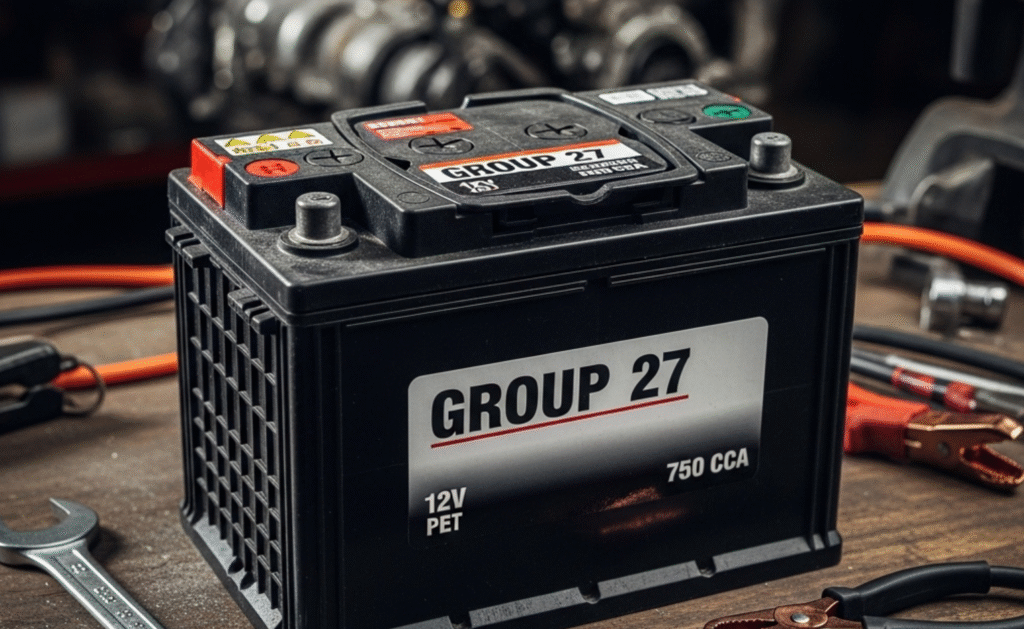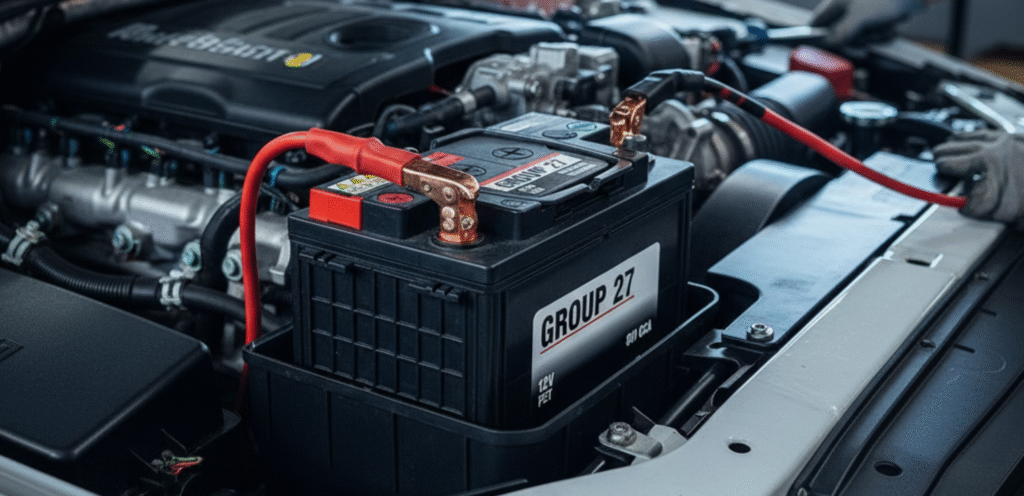When it comes to reliable power storage, Group 27 batteries are among the most widely used options in the market. You will find them in RVs, boats, solar backup systems, and even as standby power for homes and businesses. Their popularity is no accident—they offer a solid balance between capacity, size, and versatility.
This guide will walk you through everything you need to know: what a Group 27 battery is, the different types available, how they perform, their lifespan, cost factors, best applications, and even some lesser-known facts that most people overlook.

What Is a Group 27 Battery?
The term “Group 27” refers to a Battery Council International (BCI) standard for physical dimensions—not the chemistry or performance of the battery.
Dimensions: Approximately 12.05 × 6.81 × 8.89 inches (305 × 173 × 226 mm).
Voltage: Typically 12V.
Capacity Range: Between 66Ah and 110Ah, depending on the chemistry.
Weight: Usually 50–70 lbs (22–32 kg).
Because it is a size category, two Group 27 batteries from different manufacturers may look the same but have very different performance characteristics depending on their internal design.
Common Types of Group 27 Batteries
Flooded Lead-Acid (FLA)
Lowest upfront cost.
Requires regular maintenance such as topping up water.
Sensitive to vibration and must be kept upright.
Common in older RVs and entry-level solar setups.
AGM (Absorbent Glass Mat)
Maintenance-free and spill-proof.
More resistant to vibration and shock than FLA.
Higher cost than flooded batteries, but longer lifespan.
Popular in RVs, boats, and UPS systems.
Gel Battery
Uses a silica-based gel electrolyte.
Performs well in hot climates and deep discharge cycles.
Slower charging compared to AGM.
A mid-range option in terms of cost.
Lithium-Ion (LiFePO4)
Lightweight—about half the weight of lead-acid equivalents.
Long cycle life: 2000–5000 cycles.
Higher efficiency and faster charging.
High upfront cost but lowest total cost of ownership.
Ideal for deep-cycle applications like solar and marine use.
Performance and Lifespan Factors
The lifespan of a Group 27 battery depends on more than just chemistry. Key factors include:
Cycle Life:
Flooded: ~300–500 cycles.
AGM/Gel: ~500–1000 cycles.
Lithium: ~2000–5000 cycles.
Depth of Discharge (DoD):
Discharging a lead-acid battery beyond 50% significantly reduces its lifespan, while lithium can handle up to 80–90% DoD with less degradation.Temperature:
At low temperatures, lead-acid batteries lose 30–50% of usable capacity.
High temperatures accelerate chemical aging.
Lithium performs better across wider temperature ranges but may need a built-in heating system in freezing conditions.
Charging Profiles:
Lead-acid batteries require three stages (bulk, absorption, float).
Lithium batteries need chargers with proper BMS (Battery Management System) compatibility.

Best Applications for Group 27 Batteries
Recreational Vehicles (RVs)
Powering lights, refrigerators, air conditioning, and electronics.
AGM and lithium are the top choices because of vibration resistance and long cycle life.
Marine / Trolling Motors
Require durability against vibration, moisture, and salt exposure.
AGM and lithium outperform flooded options here.
Solar Power Systems
Designed for deep-cycle use with daily charge/discharge cycles.
Lithium is the best option due to efficiency and longevity.
Uninterruptible Power Supply (UPS) / Backup
AGM is most common in UPS applications thanks to reliability, sealed design, and low maintenance.
Cost and Maintenance: Short-Term vs Long-Term
Upfront Cost:
Flooded < AGM < Gel < Lithium.Long-Term Cost:
While lithium costs more initially, its longer lifespan and higher efficiency make it the most economical choice over 8–10 years.Maintenance Tips:
Avoid over-discharging (keep above 50% for lead-acid).
Use the correct charger type.
Store batteries fully charged in a cool, dry place.
Clean terminals and check voltage regularly.
Lesser-Known Facts About Group 27 Batteries
Here’s where most guides stop short. Let’s uncover some insights that even seasoned users may not know:
Group 27 = Size, Not Quality
Many people assume “Group 27” implies a specific performance level. In reality, it only defines the external dimensions. Two Group 27 batteries can differ dramatically in quality, chemistry, and performance.The Role of Internal Resistance
Even if two batteries are rated at 100Ah, a lower internal resistance means more efficient current delivery, especially under heavy loads. This is why AGM and lithium perform better than standard flooded batteries.C-Rate Matters
The “C-rate” determines how fast a battery can safely discharge. Some 100Ah Group 27 batteries are limited to low current draws, while others can power trolling motors or inverters at high output. Always check the C-rate, not just Ah.Capacity “Shrinkage” in Some Lithium Models
To reduce weight and cost, some manufacturers slightly undersize their lithium Group 27 batteries. Real usable capacity can be less than advertised. A battery monitor or load test is the only way to confirm.Recycling Differences
Lead-acid batteries are among the most recycled products in the world, with over 95% recovery rates. Lithium recycling, however, is still limited in many countries, which raises long-term environmental considerations.
Frequently Asked Questions (FAQ)
Q1: What’s the difference between Group 24, 27, and 31?
Group 24 is smaller with less capacity.
Group 27 is mid-sized and versatile.
Group 31 is larger, heavier, and offers the most capacity.
Q2: Can I use a Group 27 battery for car starting?
Yes, but Group 27 batteries are primarily designed for deep-cycle applications. For frequent cranking, a starting battery is better.
Q3: Which is better: AGM or lithium?
AGM is cheaper and maintenance-free, while lithium provides longer lifespan, lighter weight, and higher efficiency.
Q4: How long will a Group 27 battery last?
Lead-acid: 3–5 years.
AGM/Gel: 4–7 years.
Lithium: 8–10+ years.
Q5: How do I extend battery life?
Use the correct charger.
Avoid full discharges.
Keep it in moderate temperatures.
Perform regular checks.
Conclusion
Group 27 batteries strike a balance between capacity, size, and versatility, making them a go-to choice for RVs, boats, solar setups, and backup power. Choosing the right type depends on your budget and needs:
Flooded if cost is the main factor.
AGM for maintenance-free convenience.
Gel for hot climates and moderate deep-cycle use.
Lithium for long-term savings and maximum performance.
Remember: while the Group 27 label defines the battery’s size, its real value comes from understanding the chemistry, internal design, and proper usage. With the right choice and good maintenance, a Group 27 battery can serve you reliably for years.




